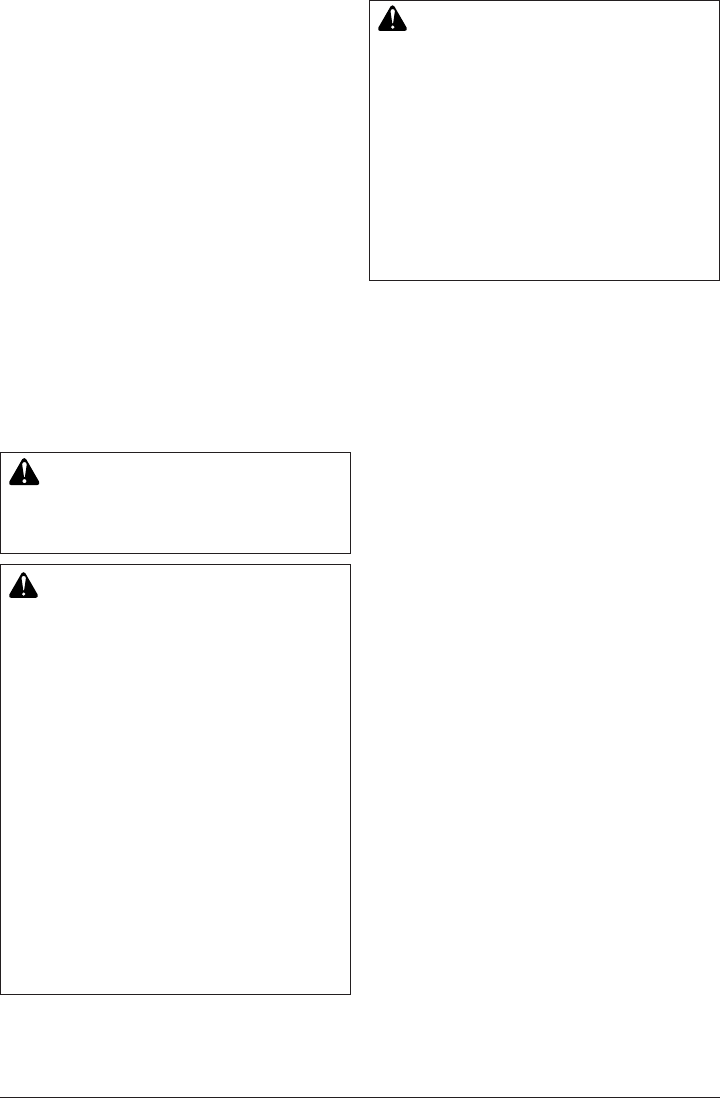
3
108540 www.desatech.com
Kickback Safety Devices On This Saw
This saw has a low-kickback chain and reduced kick-
back guide bar. Both items reduce the chance of kick-
back. Kickback can still occur with this saw.
The following steps will reduce the risk of kickback.
• Use both hands - one gripping the handle and the
other gripping the pole. Use firm grip. Thumbs and
fingers must wrap around pole and handle.
•Keep all safety items in place on saw. Make sure
they work properly.
• Do not overreach or extend arms above shoulder
height.
•Keep solid footing and balance at all times.
•Never try cutting through two branches at the same
time. Only cut one at a time.
• Do not bury guide bar nose or try plunge cut (bor-
ing into wood using guide bar nose).
•Watch for shifting of wood or other forces that may
pinch chain.
• Use extreme caution when reentering a previous cut.
• Use low-kickback chain and guide bar supplied
with the chain saw. Only use replacement parts
listed for the pole saw.
•Never use dull or loose chain. Keep chain sharp
with proper tension.
Saw Maintenance and Kickback Safety
Follow maintenance instructions in the chain saw
manual. Proper cleaning of saw and chain and guide
bar maintenance can reduce chances of kickback. In-
spect and maintain saw after each use. This will in-
crease the service life of your saw.
Note:
Even with
proper sharpening, risk of kickback can increase with
each sharpening.
IMPORTANT SAFETY
INFORMATION
Continued
WARNING: Kickback may occur when
the nose or tip of the guide bar touches
an object, or when the wood closes in
and pinches the saw chain in the cut. Tip
contact in some cases may cause a light-
ning fast reverse reaction, kicking the
guide bar up and back towards the opera-
tor. Pinching the saw chain along the top
of the guide bar may push the guide bar
rapidly back towards the operator. Either
of these reactions may cause you to lose
control of the saw which could result in
serious injury to user.
KICKBACK
WARNING: Some dust created by
power sanding, sawing, grinding, drill-
ing, and other construction activities
contains chemicals known (to the state
of California) to cause cancer, birth de-
fects, or other reproductive harm. Some
examples of these chemicals are:
• lead from lead-based paints
• crystalline silica from bricks and ce-
ment and other masonry products
• arsenic and chromium from chemi-
cally-treated lumber
Your risk from these exposures varies,
depending on how often you do this
type of work. To reduce your exposure
to these chemicals: work in a well venti-
lated area, and work with approved safety
equipment, such as those dust masks
that are specially designed to filter out
microscopic particles.
Continued
12. Do not force chain saw while cutting. Apply light
pressure. It will do the job better and safer at the
rate for which it was intended.
13. When cutting limb or tree trunk that is under ten-
sion, use extreme caution. Be alert for wood
springing back. When wood tension is released,
limb could spring back and strike operator caus-
ing severe injury or death.
14. Carry Pole Saw from one place to another
• with unit unplugged
• with telescoping pole returned to shortest po-
sition
•by holding pole at balance point (close to saw
end)
• with guide bar and chain to rear
15. Do not cut small brush and saplings with the Pole
Saw. Use the chain saw only, with extreme care.
Slender matter may catch in the chain and be
whipped toward you. This could also pull you
off balance.
WARNING: This product contains
chemicals known to the State of Califor-
nia to cause cancer or birth defects, or
other reproductive harm.


















